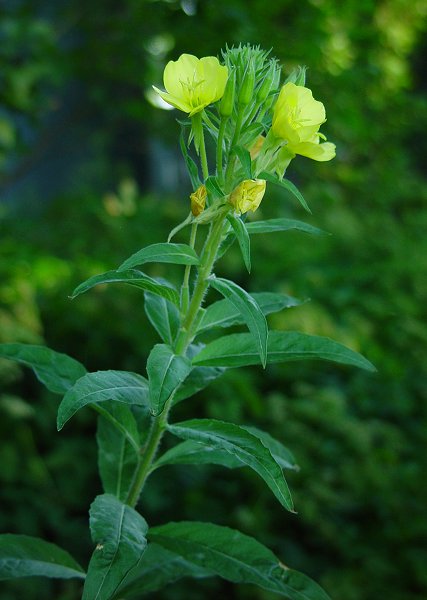Oenothera biennis L.
Common Evening Primrose

Native
CC = 0
CW = 3
MOC = 75
© DETenaglia
Oenothera biennis L.Common Evening Primrose | |
 |
Native CC = 0 CW = 3 MOC = 75 |
© DETenaglia |
|
Family - Onagraceae Habit - Taprooted biennial forb. Stems - Strongly ascending to erect, to 2 m, one to several from base, unbranched or branched, usually densely pubescent with short, upward-curved to appressed, nonglandular hairs and longer, spreading to loosely appressed, mostly pustular-based, nonglandular hairs (but the plants generally appearing green), the inflorescence with short, straight, sometimes pustular-based, nonglandular hairs, usually also with minute glandular hairs, rarely only glandular.
Leaves - Basal and alternate, the rosette leaves 10-30 cm long, 20-50 mm wide, the blade oblanceolate, tapered to the petiole, the margins somewhat irregularly toothed, sometimes few-lobed toward the base, the surfaces and margins pubescent with short, appressed to curved, nonglandular hairs. Stem leaves 5-22 cm long, 15-50 mm wide, narrowly oblanceolate to oblanceolate, tapered to the sessile or short-petiolate base, the margins irregularly toothed, those of the lower leaves sometimes with a few lobes, the surfaces and margins with pubescence similar to that of the basal leaves, the secondary veins relatively inconspicuous.
Inflorescence - Relatively dense spikes, erect and mostly straight, sometimes grouped into panicles with ascending branches, not appearing conspicuously bracteate, the bracts persistent, 12-50 mm long, narrowly lanceolate to narrowly ovate, the margins entire or finely and irregularly toothed, the surfaces sparsely to moderately pubescent with short, appressed to curved, nonglandular hairs, sometimes also with longer, spreading, nonglandular hairs and minute glandular hairs.
Flowers - Actinomorphic, opening at dusk, the floral tube 25-40 mm long, pubescent with minute glandular hairs and with sparse, short, ascending, nonglandular hairs, sometimes also with short or long, more or less spreading hairs. Sepals 12-22 mm long, not keeled, with pubescence similar to the floral tube, the free tips in bud 1.5-3.0 mm long, terminal, usually erect and appressed. Petals 12-25 mm long, 14-27 mm wide, broadly obovate to broadly heart-shaped, yellow, fading to pale yellow or orange. Stamens with the filaments 8-15 mm long, glabrous at the base, the anthers 3-6 mm long, yellow. Style 30-55 mm long, the stigma positioned at about the same level as the anthers, deeply 4-lobed, the lobes 3-6 mm long.
Fruits - Capsules 20-40 mm long, 4-6 mm wide, narrowly lanceoloid, tapered toward the tip, straight, longitudinally dehiscent nearly the entire length, 4-locular, not flattened or winged, circular in cross-section, the surface green to dull green and often with reddish stripes at maturity, moderately to densely pubescent with various types of glandular and/or eglandular hairs, not tapered to a stalklike base. Seeds numerous in each locule, arranged in 2 rows, 1.1-2.0 mm long, 0.6-1.1 mm wide, irregularly prismatic, angled, the surface brown to dark brown or nearly black, with an irregular network of ridges and pits. Self-compatible.
Flowering - June - October. Habitat - Streambanks, forest margins, glades, bluffs, fields, prairies, glades, marshes, roadsides, railroads, open disturbed areas. Origin - Native to U.S. Lookalikes - Several other species of Oenothera. Other info. - This is the most widespread and common species of evening primrose in Missouri, found throughout the state. It is likewise very common across the eastern half of the continental U.S., and occurs more sporadically farther west. It is present in many other areas of the world, on many continents. Like most species of evening primrose, this one is easy to identify to genus but harder to pin down to species. High-confidence species identification requires attention to subtle details, particularly of fruits and seeds. O. biennis is also a highly variable species and this somewhat complicates identification. Photographs taken in Marquette, MI., 7-27-02 and in the Ozark Scenic Riverways, Shannon County, MO., 8-17-03 (DETenaglia); also at Shaw Nature Reserve, Franklin County, MO, 9-16-2006, Holly Ridge Conservation Area, Stoddard County, MO, 8-15-2009, Pacific Palisades Conservation Area, St. Louis County, MO, 9-22-2012, and Danville Conservation Area, Montgomery County, MO, 8-23-2016 (SRTurner). |